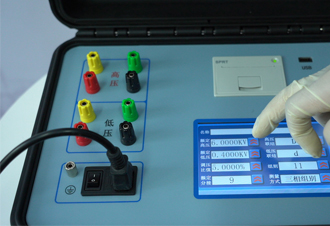 English
English


no load and short circuit test of transformer
No-Load and Short-Circuit Tests of Transformers
Transformers are crucial components in electrical power systems, as they facilitate the transmission and distribution of electrical energy across different voltage levels. Understanding the operational characteristics of transformers is essential to ensure they function efficiently and reliably. Two fundamental tests employed in transformer diagnostics are the no-load test and the short-circuit test. These tests help evaluate the transformer's performance and are integral to its design and operation.
No-Load Test
The no-load test, also known as the open-circuit test, is conducted to determine the transformer's core losses and the parameters of the equivalent circuit when the secondary winding is left open. This test is usually performed on the high-voltage side of the transformer. During the no-load test, an AC voltage is applied to the primary winding while the secondary winding remains disconnected.
The primary goal of the no-load test is to measure the no-load current, which indicates how much current the transformer draws under no-load conditions. This current is significantly small compared to full-load current and is primarily comprised of iron losses or core losses, which arise due to hysteresis and eddy currents in the transformer's core material. The power consumed during the no-load test primarily reflects these losses.
Key parameters derived from the no-load test include the no-load current, no-load loss, and magnetizing inductance. By measuring the voltage, current, and power factor during the test, engineers can determine essential characteristics of the transformer’s behavior under normal operating conditions.
Short-Circuit Test
no load and short circuit test of transformer

In contrast to the no-load test, the short-circuit test is performed to evaluate the copper losses of the transformer and to determine the equivalent series impedance. In this test, the secondary winding is shorted, and a reduced voltage is applied to the primary winding. The goal is to simulate the conditions under which the transformer operates during a fault.
The short-circuit test measures the short-circuit current and the voltage required to bring this current to the rated value. The data obtained from this test includes the impedance of the transformer, the copper losses at full load, and the voltage regulation. The copper losses are the power losses that occur in the winding conductors due to the resistance of the wire, which increases with temperature and load.
Both the no-load and short-circuit tests are crucial for assessing the transformer's efficiency and performance characteristics. The results from these tests provide valuable insights that inform transformer design, allowing engineers to optimize performance and mitigate issues that could lead to failures or inefficiencies.
Significance of the Tests
The importance of conducting these tests cannot be overstated. They help ensure that transformers operate within their specified limits and handle power effectively without overheating or suffering damage. Transformations occurring in electrical systems can have far-reaching consequences, and accurate testing allows for proactive identification of potential problems.
By analyzing the results of the no-load and short-circuit tests, engineers can design more efficient transformers, select appropriate cooling methods, and implement necessary protective measures. Ultimately, these efforts contribute to the reliability and longevity of transformers in electrical grids, ensuring a steady supply of power to consumers and industries alike.
In conclusion, the no-load and short-circuit tests are indispensable methods for evaluating transformer performance. They provide critical information regarding the operational behavior of transformers and help in maintaining the efficacy of electrical power systems. Understanding and applying these tests contribute significantly to electrical engineering practices and the stable functioning of energy infrastructure.
-
Differences between open cup flash point tester and closed cup flash point testerNewsOct.31,2024
-
The Reliable Load Tap ChangerNewsOct.23,2024
-
The Essential Guide to Hipot TestersNewsOct.23,2024
-
The Digital Insulation TesterNewsOct.23,2024
-
The Best Earth Loop Impedance Tester for SaleNewsOct.23,2024
-
Tan Delta Tester--The Essential Tool for Electrical Insulation TestingNewsOct.23,2024





